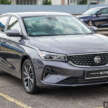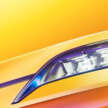This is the sixth-generation (C28) Nissan Serena, which made its global debut in November last year and is currently being showcased at the ongoing Japan Mobility Show. Pictured here is the welcab version of the MPV, specifically one that is designed with a deployable ramp at the rear of the vehicle for easy wheelchair access.
As you can see, the wheelchair occupies the third row when the seats are folded away to the side of the cabin, which is one of the configurations that Nissan offers. By removing more seats, two wheelchairs or one large wheelchair can also be fitted, providing customers with more options when transporting individuals who are confined to a wheelchair.
This is just one of several welfare-focused variants of the Serena that are sold in Japan, with other available features being retractable side steps, slide-up seats, an electric lifter (for larger wheelchairs) and additional grab handles placed throughout the cabin.
All this flexibility is made possible thanks to the spacious interior, which is packaged into an MPV that differs slightly in terms of size compared to its predecessor. The latest Serena measures between 4,690 and 4,765 mm long, between 1,695 and 1,715 mm wide, between 1,870 and 1,885 mm tall and has a wheelbase of 2,870 mm.
Meanwhile, the fifth-generation (C27) model is between 4,685 and 4,770 mm long, between 1,695 and 1,740 mm wide, 1,865 mm tall and its wheelbase spans 2,860 mm. One reason why the Serena hasn’t grown bigger is because it needs to meet the size constraints of standard automated parking systems in Japan (5,000 mm length and 1,850 mm width limit).
Design-wise, the latest Serena appears to be an evolution of its predecessor, with notable design cues being a more modern take on the brand’s signature V-motion grille, which seamlessly blends into the multi-tier headlamps.
The general profile of the MPV remains familiar, albeit with more pronounced lines on the sides, while the rear sees narrower taillights that are now separated from the reflectors – these hug the corners of the vehicle.
The interior overhaul is more substantial, as there’s now a digital instrument cluster that replaces the screens packed into a binnacle placed far up the cabin in the previous model. The new screen ahead of the driver is visually connected to the touchscreen infotainment system that is now more upright.
Other changes include more discreet air vents, with those in the middle tucked between the central touchscreen and a raised panel. The latter is smaller to provide more space to slide between the front seats, while also housing lit-when-on climate controls and gear selector buttons – no more shift lever.
The Serena in Japan also gets ProPilot (autonomous emergency braking, adaptive cruise control, collision avoidance steering assist) as standard, with higher grades getting ProPilot 2.0 that adds hands-free driving, ProPilot Remote Park and ProPilot Park with memory function.
In Japan, the Serena is offered with two powertrains, the first featuring a MR20DD 2.0 litre naturally-aspirated inline-four petrol engine that outputs 150 PS (148 hp or 110 kW) and 200 Nm of torque. This is paired with an Xtronic CVT and a choice of front- or all-wheel drive.
The second option is Nissan’s e-Power hybrid system, where a HR14DDe 1.4 litre inline-three petrol rated at 98 PS (97 hp or 72 kW) and 123 Nm acts as a generator to charge a lithium-ion battery, which then powers a front-mounted EM57 electric motor with 163 PS (161 hp or 120 kW) and 315 Nm.
The C28 is expected to be launched in Malaysia, as a camouflaged unit was sighted near Genting Highlands back in March this year. However, there’s no word on when the all-new MPV will go on sale here, but based on what you see so far, are you looking forward to it?
The post 2023 C28 Nissan Serena on display – 2.0L NA and e-Power EV; already spied in Malaysia, launching soon? appeared first on Paul Tan’s Automotive News.




